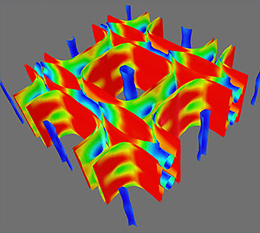Technological Materials
 Many forefront technological materials have complex crystal structures, and solving the frontier problems requires the same methods as are used to study complex Earth materials. This is true both experimentally and theoretically. Most high performance piezoelectrics, which couple acoustic and electrical energy, are ferroelectric perovskites, the same structure as the most common mineral in the Earth. Transition metal bearing polar perovskites form the new frontier area of multiferroics and magnetoelectrics, and correlated methods are required for their study. High temperature cuprate superconductors also have perovskite derivative structures, and many advances in theory and experiment have been made by Earth scientists using techniques honed in the study of Earth materials. This continues with, for example, the high pressure studies of superconductivity in the diamond anvil cell.
Many forefront technological materials have complex crystal structures, and solving the frontier problems requires the same methods as are used to study complex Earth materials. This is true both experimentally and theoretically. Most high performance piezoelectrics, which couple acoustic and electrical energy, are ferroelectric perovskites, the same structure as the most common mineral in the Earth. Transition metal bearing polar perovskites form the new frontier area of multiferroics and magnetoelectrics, and correlated methods are required for their study. High temperature cuprate superconductors also have perovskite derivative structures, and many advances in theory and experiment have been made by Earth scientists using techniques honed in the study of Earth materials. This continues with, for example, the high pressure studies of superconductivity in the diamond anvil cell.
Ferroelectrics
Nowadays theory is used to design materials that are made in the lab, with properties that agree with predictions and this has been a particularly fruitful area in ferroelectric superlattices. The discovery of single crystal relaxor ferroelectrics has revolutionised piezoelectrics for transducers used in medical ultrasound and other ultrasonic applications.
These crystals are expensive because they melt incongruently so boules generally are zoned and thus must be selected for properties (although new complex growth methods are improving the homogeneity). We will work on discovering new pure compounds with high electromechanical coupling in systems that have not yet been significantly explored, such as sulphides.
Nonlinear electromagneto-optic devices
Ferroelectric photovoltaics have been known for decades, but the origin of the observed effects has been highly controversial. Now it appears, at least in BiFeO3, that the effect is due to domain boundaries. These materials could provide much higher voltages than conventional photovoltaics, and be active throughout the material rather than at a single PN junction. We will explore non-linear optic effects in polar Mott insulators near the metal insulator transition. This could be a region of extraordinarily strong non-linear coupling for use in optical logic devices for optical computers.
Materials by design
Finally, this project will investigate active materials, especially those based on perovskites and other oxides due to their close relationship with minerals. We now have theoretical methods that can be used to design new useful materials. The work on FeO may lead to new types of transistors called MottFETS. These can be designed and studied as functions of electron and hole filling, and should have interesting and useful properties under applied magnetic fields.

